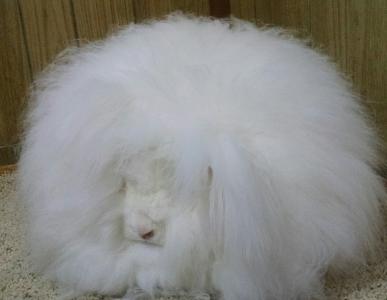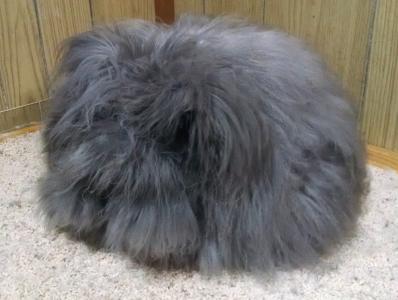Where most Angora Rabbit exhibitors beat themselves is with grooming. How to do just the right amount of grooming is the most difficult thing for the Angora Rabbit culturist to master. Groom too little, and your rabbit becomes webbed and matted. Groom too much, and your rabbit gets bald spots.
Over half of the points in the ARBA English Angora Standard of Perfection are on the wool, with 25 points assigned to density, 20 points to texture, and 12 points to length. Therefore, density is like the holy grail, and a rabbit that has as much density on its back as its sides is especially notable.
Think about it — you may be most inclined to brush your rabbit’s back, because that part is easy to brush, and the wool there is so pretty. But with every stroke, you are reducing the density of the wool. This is why it is best to do as much grooming as you can with your blower, and why more powerful blowers, like the K9 Mini, are better than other brands. Use the blower for a couple of minutes each day on your show rabbit, and you may need to brush only right behind the ears, the hind paws, and inside the “elbows.”
As the show coat begins to age, at ten months and up, you will notice some “over-ripening” as the cuticles of the fibers open up and begin to snag onto other fibers. Some of these fibers will be released, and waft off the rabbit. You must resist the urge to pick them off the rabbit with your fingers, because that will pull out multiple fibers, and end up thinning the coat. After using the blower, just ignore those, if you are at home. If you are grooming the rabbit at a show, then just flick the tips of the coat with a soft slicker brush. Do not go deep into the coat!
The rabbit with a ripening coat will need to be checked daily, to have little wads and strings of wool removed from its underside. If you don’t get those off each day, they can become soaked with urine, and might also hobble the rabbit.
At this late phase of a coat, it becomes even more important to watch for signs of wool block. I am aware that rabbit health experts now say there is really no such thing as “wool block;” that there is only gastric stasis. Nonetheless, when I have a rabbit that has a full show coat that has suddenly backed off its feed, I treat it with fur ball remedy, and it is usually eating well again by the next day. It was from Wendy Feaga, DVM, that I learned to do this.
Practical experience has taught me that judges will not usually be very concerned about some minor matting around the shoulders, if the wool of the back and sides is in good condition and falls freely. If you are too obsessive about cleaning out every little nook and cranny on show day, you might be doing more harm than good.


English Angoras in the 3 to 6 month age range may go through a period of “transition” from baby coat to adult coat, where they slough off a lot of baby fuzz. Daily use of the blower can be very helpful for preventing that baby fur from felting into the incoming adult fibers.
I like to begin grooming an Angora bunny when it is 8 weeks old. At that point, there is not a lot to do, but the handling is good for them. I will snip off any snarls that are the backs of their necks, clip the points off their claws, and brush a little. I will put the blower on the low setting, and let it run off to the side while I have the bunny in my lap, just to let it become accustomed to the sound. Better to begin grooming while they are little, than to find yourself with a bunch of mats when they are four months old.
Supposedly, our contemporary English Angora show lines are “non-molting.” That term should not be taken literally. They do molt, but it is not a synchronized molt, where all of the fur is sloughed off all at once, as with the normal coated breeds. You can make notes about which of your rabbits hold their full senior coats the best, and select for that trait.
The breed standard says that, “wool exceeding five inches is NOT to be given any advantage.” Balance and evenness of the coat are supposed to be considered, and when the wool becomes exceptionally long, it will tend to lay flat, spoiling the proverbial “round ball of fluff” appearance. There are some judges who seem to always just put the longest coats first, but most of our judges are looking for fresh, dense coats in good condition that are free of webbing and mats. I think that the prime phase of most coats is within the 8 to 10 1/2 month range.
If you can keep the lights on in your rabbitry about the same length of time each day, that might help your rabbits carry prime coats for a longer time. Another factor is keeping them cool enough.
One of the nice things about all of the Angora breeds is that after having been sheared and bred, adults can be brought back into coat and shown again. This works best for the French Angoras, because their coats are supposed to have discernible guard hair. English coats are supposed to have some guard hair as well, but some second coats may have too much. Margaret Bartold has done well with showing her senior rabbits throughout their lifetimes, with multiple coats.
Just remember: WOOL DENSITY IS THE ‘HOLY GRAIL.’
SHOW UPDATE
I have only 2 more show weekends to go to this year. Here in Kansas and Missouri, there are far fewer shows for us to attend than there are in some other regions. I am not attending the ARBA Convention in Portland.
The NARBC sweepstakes (list of high point earners) begins on August 1st each year, and runs through July 31st of the next year. I missed a lot of shows in late 2014 due to a persistent sinus infection, so I think that my 6th place final standing in the Sweepstakes is creditable. No one will ever place higher than our friend, Betty Chu, both because she has a lot more shows she can attend, and because her rabbits consistently win Best In Show.
Debbie McCormick and Kim Flowers also win a lot of Bests in Show. I’ve kind of given up, myself. I was very blessed when Muri won a Best In Show last May at a show in Missouri, but it is actually very difficult to win BIS with an Angora here in Kansas. We have some breeders of Havana, Mini Satin, and Mini Rex here in Kansas that are the best in the nation. They are smart, knowledgeable, and they have been working their lines for several years. Their rabbits are virtually impossible to beat on the BIS table.
NARBC SWEEPSTAKES AUGUST 1, 2014 THROUGH JULY 31, 2015, UNOFFICIAL
1 BETTY CHU (California)
2 CASEY JONES (California)
3 KIMBERLY FLOWERS (Florida)
4 DEBORAH MCCORMICK (North Carolina)
5 HEATHER CAMPBELL (Washington)
6 LIL PECK (Kansas)
Presently, we find ourselves with a small, but thriving group of Angora exhibitors here in Kansas and Missouri. Margaret Bartold, myself, Georgia Schafer, Greg & Penny Osborne, Anna Lang, Peggy Ashbaugh, and Laurie Holden. Exhibitor numbers tend to wax and wane, as people drift in and out of the hobby, or move away. Margaret says there have been many years when she was the lone Angora exhibitor in this area. We welcome Angora owners, whether you have them for show, or for fiber, into the Mid America Angora Club. MAAC will cohost the NARBC national show next April, in Iowa.